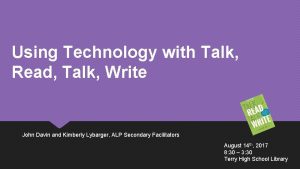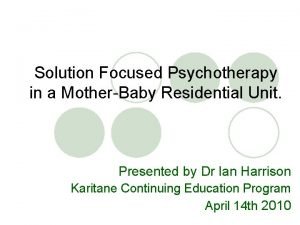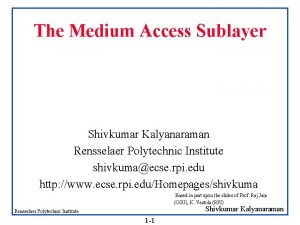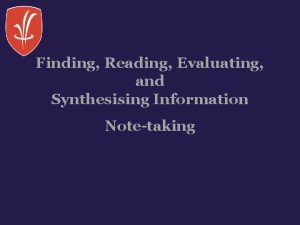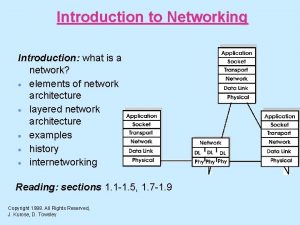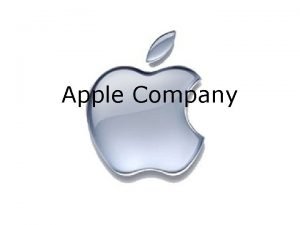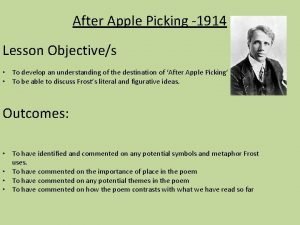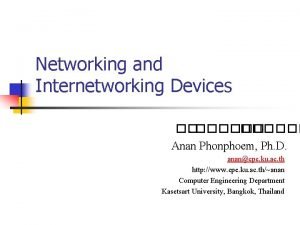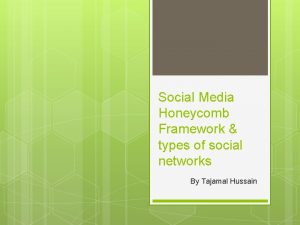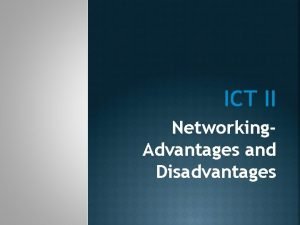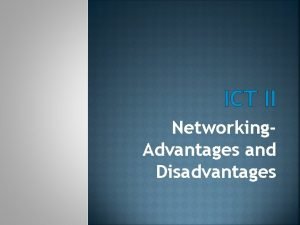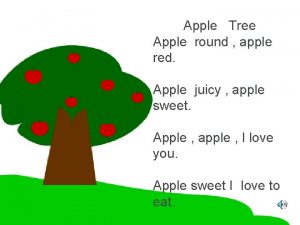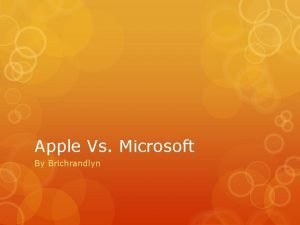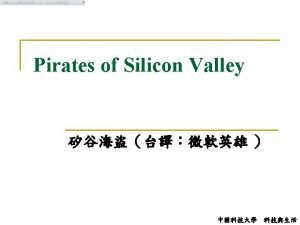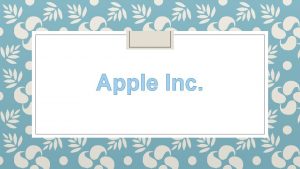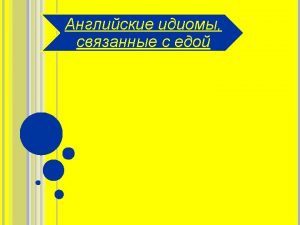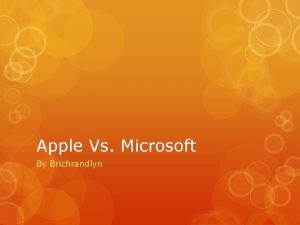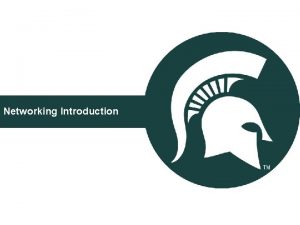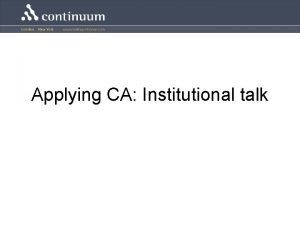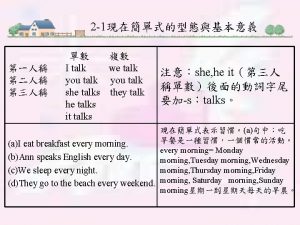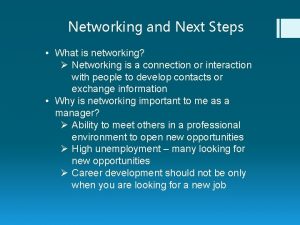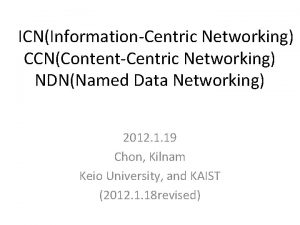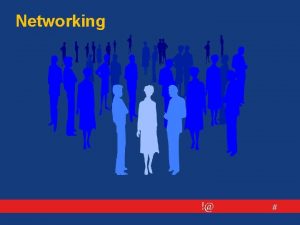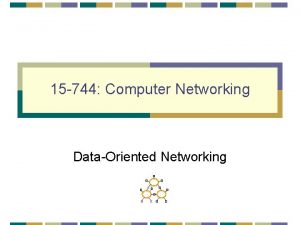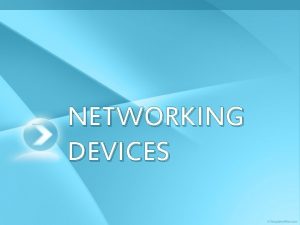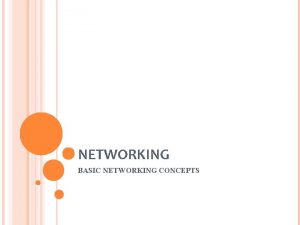Apple Talk and Networking Matt Chinnock Introduction Apple


















- Slides: 18

Apple. Talk and Networking Matt Chinnock

Introduction • Apple. Talk is a suite of protocols developed by Apple Inc for computer networking. • It was included in the original Macintosh in 1984 • Now deprecated by Apple in favor of TCP/IP networking.

Design • Appletalk followed the structure of the OSI model. • There are more protocols, some work together to achieve the same result as one OSI layer • Appletalk was not built around an Ethernet based medium • Protocols are interactive, with data moving up and down

Design

Design • One of the main features of Apple. Talk was the introduction of two configuration protocols • AARP - Apple. Talk Address Resolution Protocol • NBP - Name Binding Protocol

AARP and NBP • AARP - Allow Apple. Talk hosts to automatically generate their own network addresses • NBP - Like a DNS, it maps network addresses to user-readable names • This allowed routers to provide all of this information, or "hardwire" the system to known addresses and names.

AARP • When powered on, an Apple. Talk machine broadcasts an AARP probe packet asking for a network address, then waits to hear back from a controller, for example a router. • If another machine has that address, it will pick another address, and keep trying until it finds a free one

NBP • When a service started up on a machine, it registeres a name for itself on that machine, as chosen by the user • Names could include spaces, upper and lower case letters, and could be searched, making specific computers easy to find.

AARP and NBP Created a simple, easy to use set of network protocols New machines were added to the network simply by plugging them in, and giving them a name if they needed one. Once physically connected, an application called chooser automatically detects all peers Named one of the most, if not the most simple way of connecting computers in a network

Problems with WAN’s • Although simple and easy to use, the naming service for each peer was creating a large amount of unwanted traffic when lots of new computers on whole networks were added. • Protocols that produces unwanted network traffic is considered “chatty” • The chattiness was significantly reduced with the release of Mac OS System 7

Addressing Apple. Talk vs IP • An Apple. Talk address is 24 bits long. It contains 16 bits, or less, in the network portion of the address and 8 bits, or less, in its host portion. • A TCP/IP address is 32 bits long. Network and host portions depend on the class of the network

Addressing • Each Apple. Talk node’s address and network information is configured automatically by exchanging data from the client and server • All application-level protocols use dynamicallyassigned socket numbers at both the client and server end as well

Implementation • Hardware implementation for Apple. Talk was a high-speed serial protocol called Local. Talk • Used the Macintosh's built-in RS-422 ports, using a splitter box to allow up and downstreams. • Transfer speeds of up to 230. 4 kbit/s - fast at the time of release RS-422 Cable

Implementation • Uses a bus topology • Cable type is twisted pair • Connection Box made by Apple

Compatability • Various versions of Unix Operating Systems had support for Apple. Talk via a system called Neta. Talk, which implemented the entire suite of Apple. Talk protocols. • Most of these type are no longer used today

Apple. Talk Today • Appletalk is still used today, only now it supports the TCP/IP protocol as to enable communication with the majority of other devices • Uses Ethernet technology • Can support fiber optics • Increased distance between nodes • Supports star topology

Summary • Phase 1 and 2 no longer implemented in Macs today in favour of TCP/IP protocol suite • One of the first automated network systems • Although not used so much now, was an important step to networking today

Questions (excluding the Norwegians)
 Sdn vs traditional networking
Sdn vs traditional networking Talk, read talk write template
Talk, read talk write template Amateurs discuss tactics professionals discuss logistics
Amateurs discuss tactics professionals discuss logistics Problem talk vs solution talk
Problem talk vs solution talk Apple talk
Apple talk Synthesising information
Synthesising information Introduction to data communications and networking
Introduction to data communications and networking How to make apple jelly from apple juice
How to make apple jelly from apple juice Introduction of networking
Introduction of networking Apple company description
Apple company description Apple inc introduction
Apple inc introduction Apple objectives
Apple objectives Decision tree
Decision tree Backbone network components
Backbone network components Business data communications and networking
Business data communications and networking Honeycomb of social media
Honeycomb of social media Persuasion and networking
Persuasion and networking Disadvantages of networking computers
Disadvantages of networking computers Ictii
Ictii

